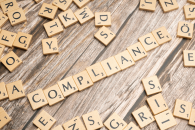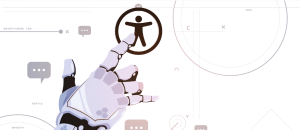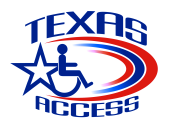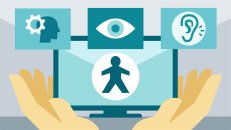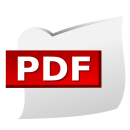The internet is the most powerful tool for social/digital inclusion; it opens the door to information and communications technologies. Access to this is essential to all users, without leaving out people with disabilities. This access is the concept behind digital accessibility.
Digital accessibility is the inclusive practice of making websites, applications, web tools, and related information such as documents available to abled and disabled people living with one form of disability or the other. To accommodate everyone, your digital content (web pages, web app, documents, interactive content, and multimedia) must be designed and developed to cater to the major disabilities that affect access to the web; such as auditory, speech, visual, physical, cognitive, and neurological disabilities.
Because the concept of accessibility is quite broad and the user-ship is equally diverse, designers and developers are encouraged to refer to the World Wide Web Consortium (W3C) guidelines and best practices for making web content accessible to all. These recommendations are called the Web Content Accessibility Guidelines (WCAG). The internationally recognized level of WCAG – WCAG 2.0 Level AA gives the same experience to users and builds accessible content by breaking down its guidelines into four categories. The level ensures web content is- perceivable, operable, understandable, and robust by working well across all browsers and devices such as assistive technologies. These categories are popularly known as ‘POUR’.
To ensure accessible designs websites and apps that are compliant with accessibility laws, WCAG 2.0 Level AA recommendations must be strictly followed in the early stage. This concept is called infrastructure accessibility and it is the most reasonable and cost-effective way of achieving digital accessibility. See Accessible Web Design & Development: [Doing It Right].
Identifying Your Current Digital Accessibility Status
It is encouraged to evaluate accessibility early on and throughout the development and designing process of the project to identify problems because it is easier to address them on the basis. When designers and developers fail at this task, (which happens nine out of ten times), you have inaccessible digital assets and interfaces. To fix this issue means identifying barriers posed to people with disabilities on your current inaccessible site. It requires a comprehensive evaluation against accessibility guidelines and requires a lot more effort.
This is where an accessibility audit, evaluation, or assessment comes in. There are accessibility testing tools that can help with this; software that enables you to find frequent and recurring accessibility issues on your web pages by testing against the international standard. They test against WCAG 2.0 Level AA and other country-specific accessibility guidelines such as Section 508– the United States federal procurement standard, BITV 2.0 of Germany, among other accessibility standards. However, the tools are limited, and no tool can determine if a site is truly accessible or even meets the accessibility guidelines. Here is where knowledgeable (experts and expert disabled users) human evaluation is required to test the website with the help of assistive technologies such as screen reader and keyboard to discover barriers that could not be identified by the accessibility testing tools. Humans determine if a site is accessible.
Digital Accessibility Solutions Available
Digital accessibility can indeed be a bit challenging and mostly requires your IT team of developers, designers, and content creators to get further training on the knowledge of building and maintaining an accessible site. Many organizations do not have this expertise and hence will look to outsource. The goal is to ensure that those with disabilities can access and operate websites, applications, documents, and other digital content so what are the solutions you require?
For the large part of accessibility, a lot of finding the solution and making your website accessible depends on your organization’s resources. More importantly, time constraints (especially in the case of litigation), financial and human resources. Notwithstanding, there are many web accessibility solutions out there offering to make your website and digital content accessible. Considering the available resources, your well-thought-out plan should answer: How do you want to go about being accessible? Accessibility statement or letter of conformance? Accessibility integration? Ongoing accessibility compliance and monitoring?
Accessibility solutions can be classified into three:
- Manual solutions
- Automatic solutions
- Hybrid solutions
Let’s examine what they each have to offer.
Manual Digital Accessibility Services
Manual accessibility is the oldest form of accessibility solution. The solution is very bespoke and approaches accessibility solutions in the form of a project. Here, a team of experts carries out an accessibility audit of your web pages, apps, digital documents, multimedia, software, etc. against accessibility regulation that affects your site- the best bet is WCAG 2.0/2.1 Level AA. Most manual solutions have their proprietary software used to perform automated testing, e.g., Deque, BoIA, and UsableNet, and they also offer a free homepage scan. Manual expert evaluation is carried out afterward to identify errors on the site and determine barriers actual individuals with disabilities face when they access the site. On completion of the automated and manual audits, they provide an informative report that prioritizes the errors and highlights the order of remediation.
Manual services guide the remediation (prioritizing issues and sequencing fixes) of your site through an Expert-in-Residence. They work with your IT team to solve complex problems and ascertain that each issue has been fixed. They also perform a validation assessment to identify accessibility issues that may have been overlooked while fixing the issues. For organizations that have been litigated (or received demand letters) or do not have the human resources or time, manual accessibility solutions can perform all these, at a charge, of course.
NB: Just like website audit, document remediation can also be a standalone manual service among the manual solutions. Documents are usually charged per page and according to the complexity.
Accessibility Statement (as required by the UK or EU accessibility requirements) or Voluntary Product Accessibility Template (VPAT) (as required by U.S Federal Agencies) can be issued to demonstrate the accessibility of the website or app, according to the WCAG 2.0 Level AA or Section 508 requirements.
There’s always a chance your web content’s accessibility will deteriorate with an increase, update, or change in content over time (3-12 months), depending on the rate of change leaving the website back to its inaccessible state. This concern is why it is essential to have plans for ongoing accessibility compliance. Ongoing accessibility compliance can be achieved in two ways. The first is to leave ongoing monitoring in the hands of your manual solution provider; this service comes at a regular charge. The second is to have your IT team trained on the knowledge they require to maintain your site’s accessibility in the long-term and be self-reliant. The training is usually custom-made and covers web, HTML5, ARIA, mobile app, accessibility testing, document accessibility, and WCAG compliance. The most important thing here is having the site tested periodically to discover issues early (you can perform monthly automated testing and carry out the tedious manual testing every few months).
Another major thing is integrating accessibility policies and standards in the organization to protect you from lawsuits. Where resources are available, both ways can be utilized. Almost all manual solutions offer training, including Criterion 508, and AKEA Web. Manual accessibility services will usually achieve accessibility within a specified duration, depending on the site’s number of operable pages, the overall user interface complexity, and the frequency and types of violations found during the system’s assessment. Remediation depends on the team’s (developers and QA) expert-level accessibility knowledge, among other factors. It is safe to put accessibility audits and remediation around a minimum of 12 weeks.
Automated Accessibility Solutions
Automated web accessibility solutions are pretty straightforward. Unlike manual solutions, they are generic and offer the same service to every website. Automated solutions can come in the form of tool-based overlays/widgets; this particular one is done by installing a line of code on your website. It automatically scans your website to solve issues within a few days from implementation and offers a widget pseudo-assistive technology on the website e.g. W-a. This accessibility widget is intended to be used by web users themselves and assist them in modifying or facilitating their website experience in real time. It should be noted that these toolbar overlays vary and can be more advanced and effective than one another. While some advanced toolbars (e.g. UserWay) re-scan to fix issues, others provide dashboards (e.g. Allyable), others do not. The accessibility plugins can be free- e.g. enable, or offer low payment like the usual ones we’ve seen with HikeOrders. Free accessibility plugins offer little accessibility usability improvement for people with disabilities (although they can be confusing), but they are usually not advanced enough to perform repetitive scans for ongoing website accessibility.
Then there are also custom overlays- JavaScript-based products targeted at dynamically fixing specific pages and websites’ accessibility issues. They are custom because the solution provider assesses your website and writes custom code that uses the JavaScript library to repair the site’s problems. Overlays are most useful when an organization is under considerable outside pressure due to a legal complaint or demand letters. Even though they also try to automatically fix accessibility issues without interfering with the website’s existing code, custom overlays are much better than the free accessibility plugins on websites. This is not to say the fix made by custom overlays won’t break if the underlying UI code changes. User1st and Deque (Amaze) have some of these products.
Either of the overlays won’t effectively remediate any structural or content-related issues on your website to make it 100% WCAG 2.0 Level AA compliant. Hence, they only make sense when implemented with the understanding that it is a temporary measure to make the lawsuit go away while a more permanent fix (audit) is put in place. This will also involve fixing multimedia (audio and videos) and document issues.
Hybrid Accessibility Services
A hybrid accessibility solution combines the services of manual and automated solutions. They perform automated and manual audits, remediate the site as manual solutions would, and provide accessibility plugins for web users to customize how they want to experience the website, offer training of your I.T team, accessibility compliance monitoring, and most likely live accessibility support on their client’s websites. Hybrid accessibility solutions can be bespoke and generic, depending on your requirements. As reflected in their services and pricing, they have managed to find a middle-ground between the two other solutions. Examples include AudioEye and Equalweb. The manual part pretty much works like manual solutions and takes about the same time while the toolbar functions like the advanced automated solutions. However, businesses should not make the mistake of getting the cheap automated widget/toolbar without the audit or remediation service as this will only result in the same result as only putting an overlay on the site- your website and app could still be inaccessible and open your organization to a lawsuit.
Digital Accessibility Services List
Providing disabled access to your digital properties benefits individuals with disabilities and has many gains for businesses. While it is highly recommended to integrate accessibility into your organization, it is not too late for businesses to make an effort to be accessible as it is one trusted way to keep lawsuits away and protect your brand reputation. To reiterate, accessibility is not a one-time thing; hence, ensure your solution provides ongoing accessibility maintenance.
You can find reviews on different web accessibility solutions on our review page. Otherwise, we have created a Google Spreadsheet that includes a list of digital accessibility solutions services that evaluate the accessibility of web content and non-web content (mobile applications, desktop applications, documents). We allow collaboration and proposals for corrections of the list or new services to be included. For this, you can send a message to adam(at)whoisaccessible.com.

